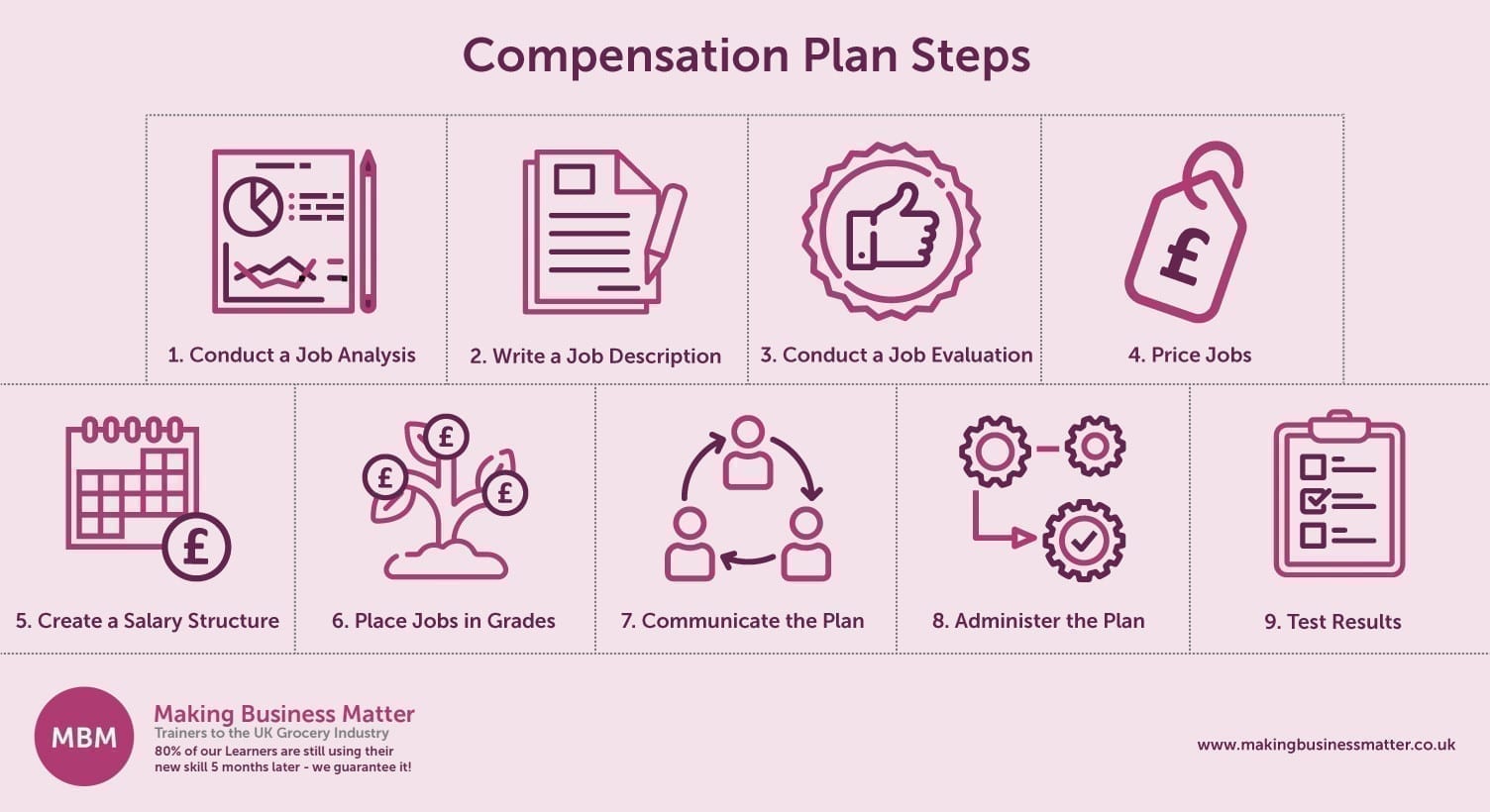Employee Compensation
A competitive compensation plan will attract, retain, and motivate employees. As an organisation grows larger, the needs of the organisation change. A good employee compensation strategy should evolve to meet the changing needs of the company. It should comprise an essential part of your HR and People Management approach.
Once you invest in the right rewards for your current employees, you are showing commitment. Moreover, you are also investing in your future employees as well. If your compensation plan is good, the organisation will attract top employees.
In this article, we will discuss different employee compensation strategies and define the steps to help you come up with the best ones for your organisation.
Employee Engagement
It is a fact that employee engagement increases with a competitive compensation and benefits package. Consequently, employees rate compensation and pay as the second most important contributor to job satisfaction.
Some employee engagement statistics you should know:
- Organisations with engaged employees had an average 3-year revenue growth.
- Companies achieve 147% higher earnings per share when hiring talented managers.
- Engaged employees are 27% more likely to report excellent performance on their reviews.
- Disengaged workers have higher absenteeism, more accidents, and more errors.
A competitive compensation package will increase productivity and job satisfaction. A good compensation package also includes benefits and other employee perks because employees may want more than just money. Furthermore, they could well leave if they feel they aren’t well compensated.
You should conduct surveys and focus groups with your current employees to find out what is important to them.
Types of Compensation
Below are some of the most used direct compensation plans:
- Base Pay is the initial rate of compensation an employee receives in exchange for services. It is the salary or hourly wage an employee receives.
- Performance-Based Compensation is a payment made based on individual or team performance. Performance review scores can influence pay.
- Seniority-Based Compensation is payment based on seniority. It is the length of time an employee has been with the company or in a position.
- Pay Differential is pay for uncomfortable or hazardous work. Some companies will pay a shift differential or shift premium. For example, it may be an increased payment for those who work third shift. Hazard pay is for dangerous or bad working conditions.
- Variable Compensation has become popular in recent years. Individual or group goals occur at the beginning of a fiscal year. If both meet or exceed those goals at the end of the year, then the individual may receive a cash bonus. These can include gainsharing, profit sharing, and employee stock ownership plans (ESOP).
- Commission and Sales Bonuses are bonuses usually paid to sales employees. They receive a percentage of sales for the products and services sold. Sometimes their base pay is lower.
- Bonus Plans are bonuses paid supplementing an employee’s base salary or hourly rate. A bonus plan is an expected incentive such as holiday bonuses.
Compensation Plan Steps Defined

You should follow the steps below to develop a competitive direct compensation plan:
1. Conduct a Job Analysis
Your human resource team should conduct a job analysis. Then, they will write a job description for each position analysed.
The purpose of the job analysis is to define the job. This will help establish good hiring, compensation, training, and performance appraisal practices. You should determine what is the best method to gather information.
- Current employees and supervisors should complete a job analysis questionnaire or task inventory sheet.
- Interview current employees and their supervisors about the positions.
- Observe them conducting their jobs if you feel you don’t have enough information.
- Get work logs kept by current employees in those positions.
2. Write a Job Description
You will use the information from the job analysis to help write a job description. Each job description should contain:
- Job Summary – Write one or two sentences summarising the position.
- Essential Functions – Use action verbs to describe each job function. Then list them in order, from the highest to the lowest performed task. The percentage of time spent on each task should reflect on the job analysis.
- Education and Experience – List education or experience you require or prefer. For example, you may require a degree, but you prefer a certain level of experience. It is very important to hire for the requirements listed here. If you know you will make exceptions, you should list the qualifications as preferred.
- Specialised Knowledge – List any specialised knowledge such as familiarity with a software program.
- Competencies – List any competencies or soft skills you would like for this position. Examples are, the ability to communicate, strong negotiation skills, strong people management skills, etc.
- Physical Requirements or Working Conditions – Include any strenuous requirements or hazardous working conditions. For example, if someone will be lifting heavy items. Or, for example, if someone is required to work outside in extreme temperatures.
Job descriptions will change and update each time the position adds more tasks.
3. Conduct a Job Evaluation
Job Evaluations are for new or changed positions. They are a method to rate and rank different positions.
Human Resource professionals will work with departmental managers to conduct the job evaluations. They review different characteristics of the job such as degree or experience. Then, they compare them to other positions in the organisation.
There are different types of methods used to conduct a job evaluation:
Ranking Method
The ranking method is the simplest, most cost-effective way for small organisations. It requires the evaluators to compare the jobs to one another.
Larger organisations may find this method complicated. For example, how do you rank employees in jobs? Especially when the education, skill, and experience levels are the same? If the jobs have the same requirements, it is more difficult.
Classification Method
The classification method involves benchmarking core positions. For example, administrative assistants and accountants. The core positions receive a market rate and placed on a vertical scale. Then, positions with similar characteristics become slotted into the same grade or level. This method can be subjective. Ensure correct ranking of the position and not the people who are doing the job.
Point Method
The point method assigns points to every position. Once you have assigned points, the position receives a pay grade or range. The evaluator reviews different components of the job. They review education requirements, skill level, the effort required, job responsibilities, and working conditions.
This method can also be subjective. It is also difficult to administer as the organisation becomes larger. However, it may be useful for some small businesses.
4. Price Jobs
To price the job, you will:
- Review the job description to understand the level and scope of the job.
- Conduct salary surveys – There are many ways to capture salary data. You can contact other companies around the area to get salary data. Also, you can get information and surveys online. Review HR membership sites like SHRM to get competitive data.
A job will pay differently based upon location as well. Furthermore, you should gather information from departing employees in exit interviews. If they are going to another company for higher pay, include that information in the data you capture.
- Review compensation components such as base pay. Investigate whether you would like to offer variable pay. You may want to consider a performance-based pay system or bonus structure.
- Recommend a salary range to members of the compensation team. If the budget allows, recommend any other compensation features such as incentive pay.
- Use several sources to help price the jobs. Also, know what the competition is paying to ensure you don’t lose your best employees.
5. Create a Salary Structure
You will start developing a salary structure based upon the budget for each position.
Determine if you will pay at market price. You may consider going under or over your competitor’s pay. Use caution if you plan to go under the market value. Be prepared to explain reasoning or other benefits.
Next, you should develop the number of salary grades and provide a range within each grade. Use the benchmark core positions to categorise the salary grades and salary ranges. Then you will determine a midpoint for each grade. Small businesses will have fewer grades than larger organisations.
When developing a salary structure, you will need to develop a range for each position. You will have a minimum, a midpoint, and a maximum amount for each job. In entry-level jobs, the ranges may be smaller.
Employees usually receive promotions when they progress in their careers. Higher level jobs will have bigger spreads to provide salary progression. The spread for entry-level jobs are usually around 15% and the spread for higher level jobs can be as high as 25-30%.
For example, you have determined the midpoint for an administrative position. You put the midpoint at £30,000. If you use the 15% spread, the minimum for that grade is £25,500 and the maximum for that grade is £34,000.
Another example, for a higher-level position such as a mid-level manager. Let’s say the midpoint for this position is £60,000 and you are using a 20% spread. The minimum for that grade is £48,000 and the maximum for that grade is £72,000. You can see the spread is much larger for career progression.
6. Place Jobs in Grades
Once you have determined the number of grades and their ranges, you will group the positions. Then, you will place them with the benchmark jobs you determined earlier. Next, you should organise them into different grades.
Finally, senior management should review the placement of all the jobs and their grades. This is a necessary step for checks and balances.
7. Communicate the Plan
Communication is necessary for all employees. Before you start the process, you should communicate with the employees. Then continue to communicate any updates throughout the process. This will help ensure there are no surprises.
You should present your pay structure to the entire organisation after completion. They need to understand the new pay structure and how the employee compensation system works.
Consider speaking to small groups to allow for questions and individual understanding.
Communicate any other compensation changes during the meetings as well. These may include bonuses or shift differentials.
8. Administer the Plan
Sometimes, an overpayment may happen for a position, this is known as a red circle rate. These are employees transferred from a higher to a lower position but were able to keep their pay. Or they may have worked for the company for a long time. Their increases may have put them over the maximum amount for the new range.
There are many reasons why this can happen, but what can you do about it?
Ensure you discuss in your compensation policy what you will do for any exceptions. These should include those in a green circle rate (employees underpaid) as well. For red circle rates, you may want to freeze a salary.
Alternatively, you may decide to give them a timeline to help them prepare for a job promotion. Whichever method you use, you should ensure you follow all legal standards. Use caution to prevent bad employee morale.
9. Test Results
As time goes on, your human resources department should assess the compensation levels. Conduct frequent anonymous salary surveys to capture information. You could consider hiring an outside source to conduct focus groups.
Also, find out from your managers what the employees are saying. If you find a job has changed, you should begin the job evaluation again for that new position.
Final Thoughts
Establishing a good employee compensation plan or total reward system may seem time-consuming. But, if done in an organised and effective manner it should be easy and clear. It is, however, essential that you are following all employment laws. Lastly, ensure you keep all information organised and confidential.
An effective and correctly implemented compensation strategy should see employee turnover decrease. Furthermore, your employees will benefit from better employee engagement increasing overall productivity.




